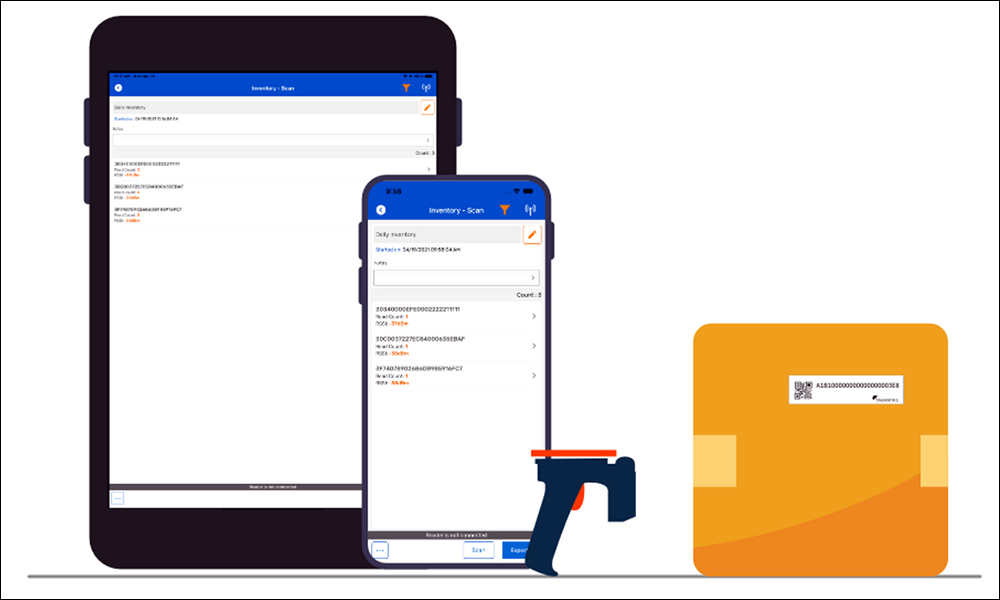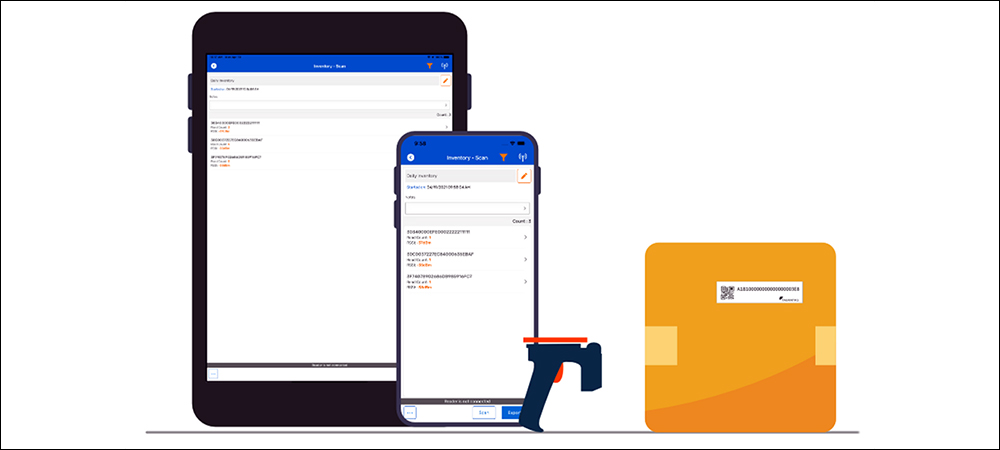- Low-Cost RFID Tool Released in 2020
- Meeting Requirements from Walmart
- Suppliers Can Leverage RFID Data In-House
- Configuration Tools and Other Features
Product suppliers striving to meet the requirements of retailers such as Walmart and Nordstrom face a host of challenges, which include getting access to tags and readers, as well as finding ways to affordably deploy the technology at their own sites around the world. With that in mind, technology company RFID4U is offering its TagMatiks Wedge application as a low-cost solution to help suppliers and other companies that face mandates to tag their products but are new to the technology.
Low-Cost RFID Tool Released in 2020
RFID4U offers its iOS- or Android-based app as a $99 tool that can be used with a handheld RFID reader tethered to a smartphone, or with a standalone handheld reader, to manage RFID tag-read data. The system is designed to be free to use for up to 500 scans before a company would need to purchase the software outright. In addition, RFID4U is offering support via its website for companies that are new to the technology or need answers to basic questions.
RFID4U is a solutions provider that supplies users with software and integration to manage RFID technology systems in their operations. Its Tagmatiks Wedge solution was released in 2020 as a low-cost option for those seeking to learn about and deploy what may be an unfamiliar technology, according to Archit Dua, RFID4U’s senior director and project manager. “This could be for use cases where people want to be able to count their assets,” Dua says, “and they already have an existing [asset-management] system but they wanted to have a very low-cost way to collect RFID data.”
This demand was growing in 2020, before the recent retailer mandates, Dua says. At that time, he explains, “We saw a gap in the market for low-cost solutions.” Therefore, the company created the Wedge app. “We wanted to keep it pretty straightforward to use, for folks to be able to collect that RFID tag data.” The earliest version of the app would allow users to deploy a handheld reader, capture read data and forward it to a Microsoft Excel file or a CSV file. The company then began adding more features to the app.

The TagMatiks Wedge app
Meeting Requirements from Walmart
In January 2022, Walmart was among the first retailers to issue a statement to suppliers requiring them to send their products with passive UHF RFID tags attached (see Walmart Recommits to RFID, Walmart Tries RFID Again and Retailer Mandates Are Like Dominoes). While the company had first targeted apparel suppliers for RFID tagging, the initiative by 2022 included home furnishings, appliances, electronics, sporting goods and toys. The retailer assigned a deadline of Sept. 2 for tagging, but it remains unclear whether all suppliers have been able to acquire the necessary RFID labels to apply to goods, due to current supply chain shortages. Walmart did not respond to a request for comment.

Archit Dua
Many suppliers, however, have begun applying RFID tags on their products in a “slap-and-ship” format, in which tags are applied at a cost to the supplier, but with little benefit since they don’t capture or use that RFID tag data. In many cases, Dua says, they tag products at factories overseas. “One of the questions folks started talking to us about,” he says, “was ‘Hey, how do we validate the tags?'” before shipping. Users can validate the RFID tags they send out by purchasing a handheld RFID reader for use with the Wedge app, and they can connect the RFID sled-style handheld to an existing smartphone or tablet using the iOS or Android app. “So there’s not a lot of IT folks involved. It’s just a direct App Store download.”
A standalone handheld reader could run the app, which is free to download for up to 500 scans, after which there’s a one-time cost of $99 per RFID device. Once users have acquired the handheld and have downloaded the app on a reading device, smartphone or tablet, they can read tags as they are being packed or shipped, thereby confirming those tags are in working condition before they are sent to the retailer.
Suppliers Can Leverage RFID Data In-House
Following that early use of an RFID reader, some suppliers are now using the Wedge app for other use cases. For instance, Dua says, some are utilizing the collected RFID data in their own business processes. “Maybe I can cycle-count the inventory of goods I’m storing in my warehouse,” he suggests. “Because if Walmart’s making me put these RFID tags on goods, there is no downside for me to start taking advantage of those tags,” by tracking what is in the warehouse or is being shipped.
A third area in which companies have begun employing RFID tag readers is in validating whether the content on the tags was encoded correctly, according to the retailer’s needs. Walmart has a specific format that suppliers must follow, using GS1‘s standards. The Wedge app has the ability to read a tag’s Electronic Product Code (EPC) ID number, and it can check the tag data’s value to make sure it follows that standard. “You can actually be able to parse out that EPC value,” Dua says, “to make sure it’s properly encoded.”
In some cases, companies are conducting spot checks to ensure the tags they print or apply to goods are correctly encoded. Users of the Wedge app can set filters to screen out RFID tags from other sources, which may be necessary for suppliers that receive materials from multiple companies, arriving onsite with their own UHF RFID tags already applied. “Companies are actually very surprised sometimes,” Dua states, “when they find out that some of their own suppliers already have RFID tags on products.” With the filtering, he explains, they can ensure that only their own tags are read.
RFID4U can make recommendations for the appropriate reading devices to use around the world. “We want to give customers options depending on the use case,” he states, “depending on the form factor of the RFID device that they want to work with, so we have a lot of different RFID devices manufacturers that we support.” Many suppliers are applying tags in the APAC region, in places such as Vietnam, Bangladesh and India, which means the tags need to be readable there, as well as along Walmart’s supply chain in North America. “The key takeaway is that we’re trying to keep it as open as possible, given the global geographies.”
Configuration Tools and Other Features
The app’s features include a reference file that allows the mapping of relevant details when tags are read. In that way, RFID4U explains, users reading tags can view the information of most interest. For instance, a company can view not just an ID number, but also a product’s description, size and price. The selected relevant data can then be displayed on the handheld device’s screen during the reading process. In addition, users can employ configuration tools within the app to capture data, such as the number of times each tag was read, or the GPS data (latitude and longitude) from the reader or smartphone at the time of the tag read.
That information can help to capture details such as whether a tag was read in a particular building or another, based on the GPS data. Users can export the read data in a format that they choose based on the configuration, such as e-mail or text message, or they can forward the data via shared drives like Google Drive or OneDrive. Additionally, they can opt for an application programming interface approach, by which they would capture data and push it directly to an enterprise resource planning or warehouse-management system. RFID4U’s website offers content to help those unfamiliar with the technology.
With hundreds of suppliers going through the initiative, Dua says, “We want to be able to incentivize them by having a low-cost approach to starting to use the technology and hopefully seeing benefits.” The app has been adopted by a handful of companies, and RFID4U hopes to see adoption continue to tick upwards as more suppliers adopt RFID. “We’ve seen, at least with the companies that we work with so far, that this application has been a great fit.” The long-term goal, he adds, is to seed the market, making RFID adoption easier and more widespread. “The biggest thing is that the simpler we make it for folks to understand, the more we encourage adoption.”
Key Takeaways:
- Before Walmart and other retailers issued RFID tagging mandates, RFID4U had already built an application intended to make RFID deployment with a handheld reader low-cost and straightforward.
- The company is now providing its solution to suppliers facing deadlines to tag their goods, so that they can gain benefits as well as from the tags’ application.


